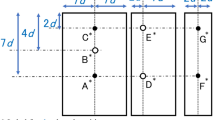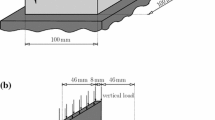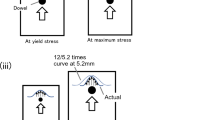Abstract
Embedment tests parallel-to-grain using dowels with different steel grades and five wood species were carried out. The specimen sampling with regard to density was random and the specimens were tested at different moisture contents. Furthermore, own tests were extended by results from literature. Observed ductility aspects using different wood species are discussed. Comparisons with the existing design equation in Eurocode 5 were made. It was found that the equation penalises species with higher densities. An adjustment of density and embedment strength to 12 % moisture content reduced the scatter considerably. Moreover, based on the test results, the sophisticated distinction of softwood in many strength classes based on minor differences in density is considered to be overly precise as far as embedment strength is concerned. An influence of the dowel steel grade was measured although the dowels remained elastic as required by standard embedment test protocols.
Zusammenfassung
Lochleibungsversuche in Faserrichtung mit fünf Holzarten und Stabdübeln unterschiedlicher Stahlgüte wurden ausgeführt. Die Zusammenstellung der Versuchskörper hinsichtlich der Rohdichte war zufällig und die Holzfeuchte zum Zeitpunkt der Versuche war unterschiedlich. Die eigenen Versuchsergebnisse wurden mit Ergebnissen aus der Literatur erweitert. Die beobachteten Duktilitätsunterschiede der verschiedenen Holzarten wurden diskutiert, und Vergleiche mit der derzeitigen Bemessungsregel in Eurocode 5 wurden gezogen, die Holzarten mit höheren Rohdichten benachteiligt. Die Anpassung der Rohdichte und der Lochleibungsfestigkeit an eine Holzfeuchte von 12 % verringerte die Streuung beträchtlich. Die Versuchsergebnisse zeigen, dass die bestehende Einteilung der Nadelhölzer in viele Festigkeitsklassen aufgrund geringer Rohdichteunterschiede zur Ermittlung der Lochleibungsfestigkeit unnötig genau ist. Ein Einfluss der Stahlgüte wurde beobachtet, obwohl, wie in den ma\(\ss\)gebenden Versuchsnormen gefordert, die Stabdübel elastisch blieben.










Similar content being viewed by others
References
Dias AMPG, van de Kuilen JWG, Cruz HMP, Lopes SMR (2010) Numerical modelling of the load-deformation behavior of doweled softwood and hardwood joints. Wood Fiber Sci 42:480–489
Ehlbeck J, Werner H (1992a) Softwood and hardwood embedding strength for dowel-type fasteners. In: CIB-W18 Meeting 25 Paper 25-7-2, Ahus, Sweden
Ehlbeck J, Werner H (1992b) Tragfähigkeit von Laubholzverbindungen mit stabförmigen Verbindungsmitteln. Technical report, Forschungsbericht Versuchsanstalt für Stahl, Holz und Steine, Abt. Ingenieurholzbau, Universität Karlsruhe, Germany
EN-12512 (2001) Timber structures-test methods-cyclic testing of joints made with mechanical fasteners. European Committee for Standardisation, Brussels, Belgium
EN-1995-1-1 (2004) Eurocode 5. Design of timber structures—part 1-1: general-common rules and rules for buildings. European Committee for Standardisation, Brussels, Belgium
EN-338 (2009) Structural timber-strength classes. European Committee for Standardisation, Brussels, Belgium
EN-383 (2007) Timber structures-test methods-determination of embedment strength and foundation values for dowel-type fasteners. European Committee for Standardisation, Brussels, Belgium
EN-384 (2004) Structural timber-determination of characteristic values of mechanical properties and density. European Committee for Standardisation, Brussels, Belgium
Hübner U, Bogensperger T, Schickhofer G (2008) Embedding strength of European hardwoods. In: CIB-W18 Meeting 41 Paper 41-7-5, St. Andrews by-the-Sea, Canada
Van de Kuilen JWG (1999) The residual load carrying capacity of timber joints. Heron 44(3):187–214
Van de Kuilen JWG, Blass HJ (2005) Mechanical properties of azobé (Lophira alata). Holz Roh Werkst 63(1):1–10
NEN-5493 (2010) Quality requirements for hardwoods in civil engineering works and other structural applications. Nederlandse Norm, Delft, The Netherlands
Rodd PD (1973) The analysis of timber joints made with circular dowel connectors. Dissertation. University of Sussex, UK
Sandhaas C (2012) Mechanical behaviour of timber joints with slotted-in steel plates. Dissertation. Delft University of Technology, Delft, The Netherlands
Sawata K, Yasumura M (2002) Determination of embedding strength of wood for dowel-type fasteners. J Wood Sci 48(2):138–146
Sosa Zitto M, Köhler J, Piter J (2012) Embedding strength in joints of fast-growing Argentinean Eucalyptus grandis with dowel-type fasteners. Analysis according to the criterion adopted by European standards. Eur Wood Prod 70:433–440
Vreeswijk B (2003) Timber joints using hardwood species. Master thesis. Faculty of Civil Engineering, Delft University of Technology, Delft, The Netherlands
Whale LRJ, Smith I (1986a) The derivation of design clauses for nailed and bolted joints in Eurocode 5. In: CIB-W18 Meeting 19 Paper 19-7-6, Florence, Italy
Whale LRJ, Smith I (1986b) Mechanical joints in structural timber -Information for probabilistic design. Technical report, report 17/86, TRADA, High Wycombe, UK
Whale LRJ, Smith I (1986c) Mechanical timber joints. Technical report, report 18/86, TRADA, High Wycombe, UK
Whale LRJ, Smith I (1989) A method for measuring the embedding characteristics of wood and wood-based materials. Mater Struct 22:403–410
Author information
Authors and Affiliations
Corresponding author
Rights and permissions
About this article
Cite this article
Sandhaas, C., Ravenshorst, G.J.P., Blass, H.J. et al. Embedment tests parallel-to-grain and ductility aspects using various wood species. Eur. J. Wood Prod. 71, 599–608 (2013). https://doi.org/10.1007/s00107-013-0718-z
Received:
Published:
Issue Date:
DOI: https://doi.org/10.1007/s00107-013-0718-z




